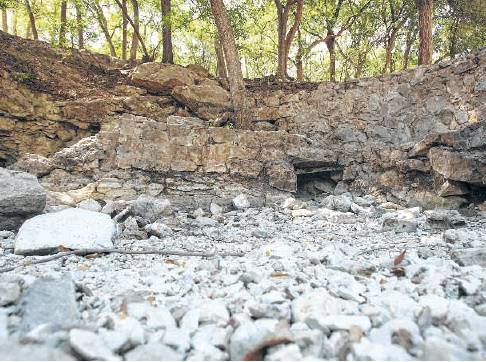Warming may hurt Edwards Aquifer
Report: Climate change, population growth could threaten water supply in next 50 years
By Scott Huddleston STAFF WRITER
The Edwards Aquifer could be at risk in the next 50 years as a result of warmer temperatures and more frequent and severe droughts, compounded by population growth.
“These climate change impacts will be exacerbated in central Texas’s rapidly urbanizing regions, as increasing impervious cover will affect water quality and rates of runoff and recharge,” stated the Fourth National Climate Assessment, a 1,656-page report released by the federal government.
Officials in California, Florida and other coastal states are increasingly concerned about heat, sea levels and severity of storms in a warming world, said Doug Melnick, the city of San Antonio’s chief sustainability officer.
But San Antonio, too, is vulnerable to the effects of climate change, Melnick said.
Already, extreme floods in San Antonio have prompted authorities to redraw flood maps and demolish homes, includes those along Salado Creek on the East Side that were ravaged by a 1998 flood and others along Barbara Drive on the North Side that were damaged by a 2013 deluge.
“We’re seeing discussions as we speak, statewide and nationally, about adjusting 100-year and 500-year flood zones,” Melnick said. “That’s going on now, and that really is the direct result of climate change.”
Officials of the Edwards Aquifer Authority are preparing to quantify the potential impact of climate change on the severity of droughts in the region. But the authority said it would be “premature” to predict “a degradation of habitat for species of concern,” an outcome projected in the National Climate Assessment released last month.
Studies have found that conservation measures adopted in 2012 “are enough to maintain spring flows that are critical to the habitat” of fountain darters and other endangered species, “even if a drought as severe as the 1950s was repeated,” EAA General Manager Roland Ruiz said.
“What is more probable is that these conservation measures would need to be implemented more frequently to maintain critical spring flows in a warmer climate,” he said.
For homeowners, that would mean more frequent limits on lawn watering. San Antonio currently is under year-round watering rules, which allow sprinkler use any day before 11 a.m. and after 7 p.m.
San Antonio’s 1947-1957 drought was surpassed in intensity by a 2008-2014 dry spell, according to the new federal climate report.
“What made 2011 so bad was the long streak of record-breaking temperatures,” Ruiz said. “If not for having a moderately wet 2010, this drought would have rivaled the 1950s drought.”
In its 2017 Water Management plan, which seeks to project conditions more than 50 years into the future, the San Antonio Water System created a worse-case drought scenario based on past droughts.
“The lessons from every drought continue to be that managing our long-term water future is a mixture of having adequate supplies and continuing to commit to conservation,” said Donovan Burton, vice president of water resources and government relations at SAWS.
From 1982 to 2016, San Antoni-ans reduced water use from 225 gallons per person daily to 117 gallons, according to SAWS. Through leak-detection technologies and conservation measures, the utility hopes to further lower consumption to 88 gallons daily by 2070.
But SAWS also expects to serve 1.4 million more people by then, for a total of 3.2 million. After reducing reliance on the Edwards from 70 percent of its water supply in 2000 to 42 percent today, SAWS aims to further reduce use of Edwards Aquifer water to 31 percent by 2070.
It is also adding an important new source of supply: The 142-mile Vista Ridge pipeline is scheduled to start delivering water from the Carrizo-Wilcox Aquifer in Central Texas in April 2020.
“The diversification of San Antonio’s water supply is key to ensuring the city has the appropriate supply of water to meet the needs of a growing economy,” Donovan said.
The SAWS water plan predicts the possibility of a small “supply gap” in 2050, amounting to 5,757 acre-feet. But the utility says it could expand its brackish water desalination plant or the Carrizo Aquifer project to close the gap.
Another key concern in the federal climate report is that urban growth will result in “increasing impervious cover” — buildings and pavement — reducing the amount of water that seeps into the Edwards Aquifer through porous limestone formations.
The city’s climate action and adaptation plan is scheduled for release in draft form next month. City Council is scheduled to adopt the plan in April. The document is expected to focus heavily on reducing greenhouse gas emissions and mitigating temperature increases. It also will also include a water and natural resources component.
The plan may include recommendations for “improvements to urban landscapes, stormwater management and improvements to soils to better store carbon and retain water — all of which could help protect the aquifer,” the EAA’s Ruiz said.
During the last drought, an EAA program paid farmers to the west of San Antonio not to irrigate, leaving water in the aquifer. In addition, the SAWS Aquifer Storage and Recovery facility south of the city — the nation’s largest groundwater-based storage facility — currently holds 170,000 acre-feet, more than two-thirds of the utility’s annual demand.
Ruiz noted that the new federal report projects increases in annual average temperatures in the Southern Great Plains of 3.6 to 5.1degrees Fahrenheit by 2050, and 4.4 to 8.4 degrees by 2100. That would raise evaporation rates, reducing aquifer recharge. But the report noted that the types and frequency of severe weather were difficult to predict, Ruiz said.
“There is some evidence that local-scale severe storms can become worse and produce more rainfall, but periods between storm events could be drier — in part due to the higher temperatures,” he said. “So, stronger storms could at least partially offset some of the effects of higher temperatures.” shuddleston@express-news.net
Twitter: @shuddlestonSA
